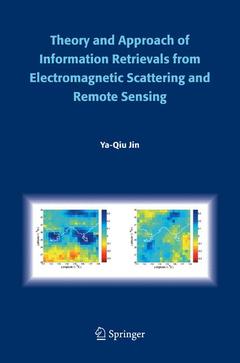Description
Theory and Approach of Information Retrievals from Electromagnetic Scattering and Remote Sensing, Softcover reprint of the original 1st ed. 2006
Author: Jin Ya-Qiu
Language: English
Subject for Theory and Approach of Information Retrievals from...:
Approximative price 158.24 €
In Print (Delivery period: 15 days).
Add to cartPublication date: 08-2016
Support: Print on demand
Approximative price 158.24 €
Subject to availability at the publisher.
Add to cartPublication date: 12-2005
386 p. · 15.5x23.5 cm · Hardback
Description
/li>Contents
/li>Biography
/li>Comment
/li>
Ya-Qiu Jin received the B.S. degree from Peking University (1970), and the M.S. (1982), E.E. (1983) and Ph.D. (1985) degrees from the Department of Electrical engineering and Computer Science, Massachusetts Institute of Technology, USA.
He was a Research Scientist at the Atmospheric and Environmental Research Inc. in Cambridge, USA (1985), Research Associate at the City University of New York (1986-1987), Visiting Professor at the University of York, UK (1993-94) sponsored by the UK Royal Society and at the City University of Hong Kong (2001). He held the Senior Research Associateship at NOAA/NESDIS awarded by the USA National Research Council (1996).
He is full Professor in the School of Information Science and Engineering, and Director of the Key Laboratory of Wave Scattering and Remote Sensing Information (Ministry of Education), Fudan University, Shanghai, China. He has been appointed as the Principal Scientist for the China State Major Basic Research Project (2002-2007) by the Ministry of National Science and Technology of China to lead the remote sensing state program in China.
He has been elected as the IEEE Fellow for his contribution of electromagnetic scattering model for remote sensing application. He is the founder and Chairman (1995-2003) of IEEE GRSS China Chapter.
He has published over 430 papers in China and abroad, and six books (two are in English: Electromagnetic Scattering Modeling for Quantitative Remote Sensing by Singapore: World Scientific (1994), Information of Electromagnetic Scattering and Radiative Transfer in Natural Media by Beijing: Science Press (2000)). He is the Editor of SPIE Volume 3503: Microwave Remote Sensing of the Atmosphere and Environment by USA: SPIE, and the book: Wave Propagation, Scattering and Emission in Complex Media by Singapore: World Scientific and Beijing: Science Press (2004). He is Chairman of ISAPE2000 and the International Specialist Workshop 2004 on EM Scattering and Informati
Covers several hot topics in current research of electromagnetic scattering, and radiative transfer in complex and random media, polarimetric scattering and SAR imagery technology, data validation and information retrieval from space-borne remote sensing, computational electromagnetics, etc.
Including both forward modelling and inverse problems, analytic theory and numerical approaches
An overall summary of the author’s works during most recent years
Also presents some insight for future research topics



